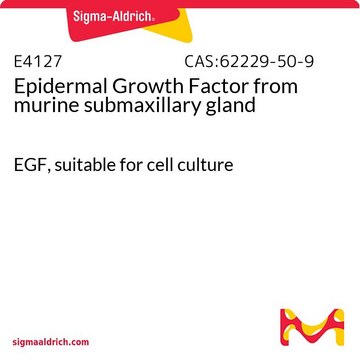Key Documents
E9644
Epidermal Growth Factor, human
≥97% (SDS-PAGE), recombinant, expressed in E. coli, lyophilized powder, suitable for cell culture
Synonim(y):
Epidermal Growth Factor human, EGF
About This Item
Polecane produkty
product name
hEGF, EGF, recombinant, expressed in E. coli, lyophilized powder, suitable for cell culture
pochodzenie biologiczne
human
Poziom jakości
rekombinowane
expressed in E. coli
Próba
≥97% (SDS-PAGE)
Postać
lyophilized powder
siła działania
0.08-0.8 ng/mL ED50/EC50
masa cząsteczkowa
~6 kDa
opakowanie
pkg of 5X0.2 mg
pkg of 0.2 mg
pkg of 0.5 mg
warunki przechowywania
avoid repeated freeze/thaw cycles
metody
cell culture | mammalian: suitable
zanieczyszczenia
≤1 EU/μg endotoxin (EGF)
kolor
white
rozpuszczalność
water: soluble, clear, colorless
numer dostępu UniProt
temp. przechowywania
−20°C
informacje o genach
human ... EGF(1950)
Szukasz podobnych produktów? Odwiedź Przewodnik dotyczący porównywania produktów
Zastosowanie
Działania biochem./fizjol.
Cellular functions affected by EGF: mitosis, ion flux, glucose transport, glycolysis, nucleic acid and protein synthesis, survival, growth, proliferation and differentiation.
Biological affects of EGF: inhibition of gastric acid secretion, fetal growth and development and neuromodulation in the central nervous system.
Pathways affected by EGF: EGFR signaling, MAPK cascade, PIP, Ca+2 signaling
Komponenty
Przestroga
Uwaga dotycząca przygotowania
Komentarz do analizy
Kod klasy składowania
11 - Combustible Solids
Klasa zagrożenia wodnego (WGK)
WGK 3
Temperatura zapłonu (°F)
Not applicable
Temperatura zapłonu (°C)
Not applicable
Środki ochrony indywidualnej
Eyeshields, Gloves, type N95 (US)
Certyfikaty analizy (CoA)
Poszukaj Certyfikaty analizy (CoA), wpisując numer partii/serii produktów. Numery serii i partii można znaleźć na etykiecie produktu po słowach „seria” lub „partia”.
Masz już ten produkt?
Dokumenty związane z niedawno zakupionymi produktami zostały zamieszczone w Bibliotece dokumentów.
Klienci oglądali również te produkty
Produkty
rganoid culture products to generate tissue and stem cell derived 3D brain, intestinal, gut, lung and cancer tumor organoid models.
Produkty do hodowli organoidalnej do generowania trójwymiarowych modeli mózgu, jelit, jelit, płuc i guzów nowotworowych pochodzących z tkanek i komórek macierzystych.
Protokoły
A stem cell culture protocol to generate 3D NSC models of Alzheimer’s disease using ReNcell human neural stem cell lines.
Protokół hodowli komórek macierzystych do generowania modeli 3D NSC choroby Alzheimera z wykorzystaniem linii ludzkich neuronalnych komórek macierzystych ReNcell.
Step-by-step culture protocols for neural stem cell culture including NSC isolation, expansion, differentiation and characterization.
Nasz zespół naukowców ma doświadczenie we wszystkich obszarach badań, w tym w naukach przyrodniczych, materiałoznawstwie, syntezie chemicznej, chromatografii, analityce i wielu innych dziedzinach.
Skontaktuj się z zespołem ds. pomocy technicznej







